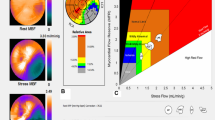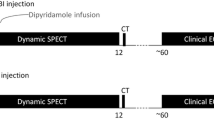Abstract
Contradictory data have been published on the relative behaviour of fatty acids and flow tracers during the subacute stage of myocardial infarction. Therefore, the present study was set up (1) to investigate the potential occurrence of mismatches between β-methyl-iodophenyl pentadecanoic acid (BMIPP), a fatty acid analogue, and Sestamibi, and to describe their nature, and (2) to relate these mismatches to clinical characteristics such as whether or not thrombolysis or percutaneous transluminal coronary angioplasty (PTCA) had been performed. Twenty-six patients were studied within 2 weeks after myocardial infarction. Sestamibi and BMIPP single-photon emission tomography (SPET) were performed within 4 days of one another. Activity of both tracers was scored in 16 basal, 16 midventricular and 8 apical segments, using a four-point grading system: 3 = normal (≥65% of maximum activity), 2 = mildly decreased (45%–64%), 1 = moderately decreased (25%–44%), 0 = severely decreased (0%–24%). Coronary arteriography was obtained during the same hospital stay. Four hundred and seventy-seven segments out of 1040 studied were abnormal for at least one tracer: 197 with higher Sestamibi activity (group I), 226 with equal scores for Sestamibi and BMIPP (group II) and 54 with higher BMIPP activity (group III). Seventy-five percent of group I segments and 84% of group III segments were found in infarct-related artery territories. Group I segments were associated with acute thrombolysis and/or PTCA (P < 0.01), and with the absence of prior infarction in the territory of the infarct-related artery (P < 0.001). Group III segments were associated with the absence of thrombolysis or PTCA (P < 0.001), with occlusion of the infarct-related artery (P < 0.001), with previous infarction in the same territory (P < 0.001) and with a- or dyskinesia in this territory (P < 0.001). These data could support the interpretation that areas in which the uptake of BMIPP is more decreased than that of Sestamibi (group I) are due to delayed recovery of fatty acid metabolism after reperfusion, whereas those with higher BMIPP than Sestamibi activity (group III) are accounted for by the enhanced metabolism induced by passive systolic wall stretch.
Similar content being viewed by others
References
Tamaki N, Kawamoto M, Yonekura Y, Fujibayashi Y, Takahashi N, Konishi J, Nohara R, Kambara H, Kawai C, Ikekubo K, Kato H. Regional metabolic abnormality in relation to perfusion and wall motion in patients with myocardial infarction: assessment with emission tomography using an iodinated branched fatty acid analog.J Nucl Med 1992;33:659–667.
Saito T, Yasuda T, Gold HK, Leinbach R, Livni E, Elmaleh D, Callahan R, Barlai-Kovach M, Wilkinson R, Fischman AJ, Strauss HW. Differentiation of regional perfusion and fatty acid uptake in zones of myocardial injury.Nucl Med Commun 1991;12:663–675.
Franken PR, De Geeter F, Dendale P, Block P, Bossuyt A. Regional distribution of231-(ortho-iodophenyl)-pentadecanoic acid and99mTc-MIBI in relation to wall motion after thrombolysis for acute myocardial infarction.Nucl Med Commun 1993;14:310–317.
Mertens J, Eersels J, Vanryckeghem W. New high yield Cu(1) assisted123I- radioiodination of 15 (p-l-phenyl)-9-methyl pentadecanoic acid, a potential myocardial tracer.Eur J Nucl Med 1987;13:159–160.
DePasquale EE, Nody AC, DePuey EG, Garcia EV, Pilcher G, Bredlau C, Roubin G, Gober A, Gruentzig A, D'Amato P, Berger HJ. Quantitative rotational thallium-201 tomography for identifying and localizing coronary artery disease.Circulation 1988;77:316–327.
ujibayashi Y, Yonekura Y, Takemura Y, Wada K, Matsumoto K, Tamaki N, Yamamoto K, Konishi J, Yokoyama A. Myocardial accumulation of iodinated beta-methyl-branched fatty acid analogue, iodine-125–15-(p-iodophenyl)-3-(R, S) methyl pentadecanoic acid (BMIPP), in relation to ATP content.J Nucl Med 1990;31:1818–1822.
Knapp FF, Ambrose KR, Goodman MM. New radioiodinated methyl-branched fatty acids for cardiac studies.Eur J Nucl Med 1986;12:S39-S44.
Nishimura T, Sago M, Kihara K, Oka H, Shimonagata T, Katabuchi T, Hayashi M, Uehara T, Hayashida K, Noda H, Takano H. Fatty acid myocardial imaging using123I-a-methyl-iodo-phenyl pentadecanoic acid (BMIPP): comparison of myocardial perfusion and fatty acid utilization in canine myocardial infarction (occlusion and reperfusion model).Eur J Nucl Med 1989;15:341–345.
iller DD, Gill JB, Livni E, Elmaleh DR, Aretz T, Boucher CA, Strauss HW. Fatty acid analogue accumulation: a marker of myocyte viability in ischemic-reperfused myocardium.Circ Res 1988;63:681–692.
Kurata C, Kobayashi A, Yamazaki N. Dual-tracer autoradiographic study with thallium-201 and radioiodinated fatty acid in cardiomyopathic hamsters.J Nucl Med 1989;30:80–87.
Kurata C, Tawarahara K, Taguchi T, Aoshima S, Kobayashi A, Yamazaki N, Kawai H, Kaneko M. Myocardial emission computed tomography with iodine-123-labeled beta-methyl-branched fatty acid in patients with hypertrophic cardiomyopathy.J Nucl Med 1992;33:6–13.
Yonekura Y, Brill AB, Som P, Yamamoto K, Srivastava S, Iwai J, Elmaleh D, Livni E, Strauss H, Goodman M, Knapp F. Regional myocardial substrate uptake in hypertensive rats: a quantitative autoradiographic measurement.Science 1985;227:1494–1496.
Yamamoto K, Som P, Brill AB, Yonekura Y, Srivastava SC, Meinken GE, Iwai J, Goodman MM, Knapp FF Jr, Elmaleh DR, Livni E, Strauss HW. Dual-tracer autoradiographic study of β-methyl-(1-14C)heptadecanoic acid and 15-p-(131I)-iodophenyl-β-methylpentadecanoic acid in normotensive and hypertensive rats.J Nucl Med 1986;27:1178–1183.
Devous MD, Lowe JL, Payne JK. Dual-isotope brain SPECT imaging with technetium-99m and iodine-123: validation by phantom studies.J Nucl Med 1992;33:2030–2035.
Nishimura T, Uehara T, Shimonagata T, Kumita S, Nonogi H, Haze K. Clinical assessment of stunned myocardium using123I-BMIPP myocardial imaging in relation to myocardial perfusion, metabolism and ventricular function [abstract].J Nucl Med 1991;32:1012.
Tamaki N, Kawamoto M, Yonekura Y, Takahashi N, Magata Y, Fujibayashi Y, Nohara R, Kambara H, Kawai C, Konishi J. Decreased uptake of I-123 BMIPP as a sign of enhanced glucose utilization assessed by FDG-PET [abstract].J Nucl Med 1991;32:1034.
Knabb RM, Bergmann SR, Fox KAA, Sobel BE. The temporal pattern of recovery of myocardial perfusion and metabolism delineated by positron emission tomography after coronary thrombolysis.J Nucl Med 1987;28:1563–1570.
Schwaiger M, Schelbert HR, Ellison D, Hansen H, Yeatman L, Vinten-Johansen J, Selin C, Barrio J, Phelps M. Sustained regional abnormalities in cardiac metabolism after transient ischemia in the chronic dog model.J Am Coll Cardiol 1985;5:336–347.
Wackers FJT, Gibbons RJ, Verani MS, Kayden DS, Pellikka PA, Behrenbeck T, Mahmarian JJ, Zaret BL. Serial quantitative planar technetium-99m isonitrile imaging in acute myocardial infarction: efficacy for noninvasive assessment of thrombolytic therapy.J Am Coll Cardiol 1989;14:861–873.
Gibbons RJ, Verani MS, Behrenbeck T, Pellikka PA, O'Connor MK, Mahmarian JJ, Chesebro JH, Wackers FJ. Feasibility of tomographic 99mTc-hexakis-2-methoxy-2-methylpropyl-isonitrile imaging for the assessment of myocardial area at risk and the effect of treatment in acute myocardial infarction.Circulation 1989;80:1277–1286.
Bolli R. Mechanism of myocardial “stunning”.Circulation 1990;82:723–738.
Wijns W, Heyndrickx GR, Vogelaers D, Vanoverschelde JJ, Bol A, Essamri B, Grandin C, Melin J. Metabolic imaging in postischemic canine myocardium. In: Zaret BL, Beller GA, eds.Nuclear cardiology. Saint Louis Baltimore: Mosby; 1993:284–293.
Piwnica-Worms D, Chiu ML Kronauge JF. Divergent kinetics of201TI and99mTc-Sestamibi in cultured chick ventricular myocytes during ATP depletion.Circulation 1992;85:1531–1541.
Ross J Jr. Myocardial perfusion-contraction matching: implications for coronary heart disease and hibernation.Circulation 1991;83:1076–1083.
Author information
Authors and Affiliations
Rights and permissions
About this article
Cite this article
De Geeter, F., Franken, F.R., Knapp, F.F. et al. Relationship between blood flow and fatty acid metabolism in subacute myocardial infarction: a study by means of99mTc-Sestamibi and23I-β-methyl-iodo-phenyl pentadecanoic acid. Eur J Nucl Med 21, 283–291 (1994). https://doi.org/10.1007/BF00947962
Revised:
Issue Date:
DOI: https://doi.org/10.1007/BF00947962




